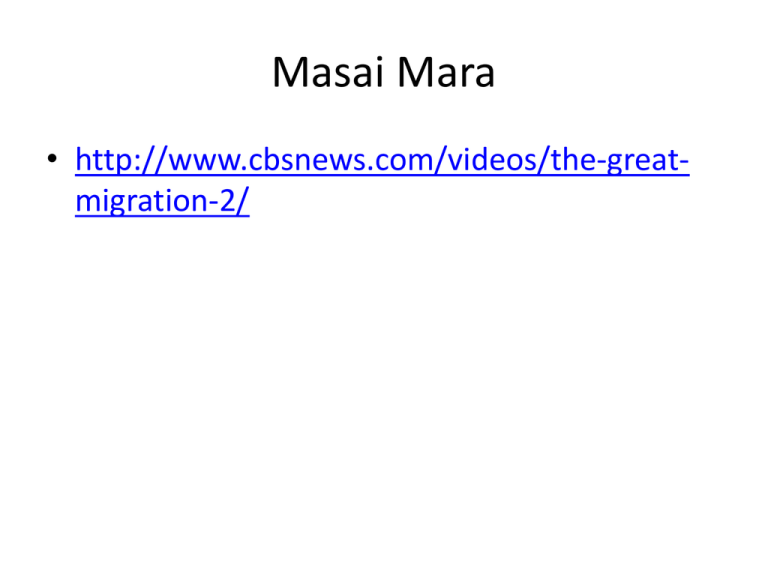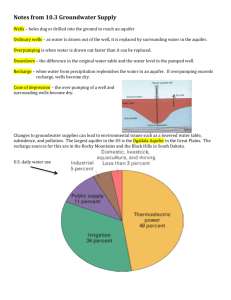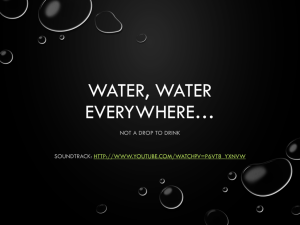Presentation
advertisement

Masai Mara • http://www.cbsnews.com/videos/the-greatmigration-2/ GLOBAL WATER CRISIS • Water - the essential ingredient for life on this planet – is becoming an increasingly scarce resource. According to the World Bank and World Health Organization, 2 billion people lack access to clean water and 1 billion people do not have enough to even meet their daily needs. • Every day an increasing amount of pollution seeps into rivers and lakes making them toxic to humans, and underground aquifers – our most significant sources of water – are being depleted at an alarming rate. • By 2050 the number of people on the planet is projected to exceed 9 billion, and if current trends continue more and more useable water will be lost. Making an adequate supply of water available to everyone alive today is a monumental task, and ensuring that there is enough water for all future generations will require an unprecedented level of international cooperation and compassion… This picture shows the size of a sphere that would contain all of Earth's water in comparison to the size of the Earth. The blue sphere sitting on the United States, reaching from about Salt Lake City, Utah to Topeka, Kansas, has a diameter of about 860 miles (about 1,385 kilometers) , with a volume of about 332,500,000 cubic miles (1,386,000,000 cubic kilometers). The sphere includes all the water in the oceans, seas, ice caps, lakes and rivers as well as groundwater, atmospheric water, and even the water in you, your dog, and your tomato plant. Water’s Importance, Availability and Renewal Our liquid planet glows like a soft blue sapphire in the hard-edged darkness of space. There is nothing else like it in the solar system. It is because of water. John Todd https://www.youtube.com/watch?v=Q54a4PCV9Ac https://www.youtube.com/watch?v=VIaw5mCjHPI Why is water so important-lifeblood of ecosystem Many Properties Related to Polarity-Strong Hydrogen Bonding Aquifer: groundwater exists in the multitude of small spaces found within permeable layers of rock and sediment. Unconfined: water can flow in and out Confined: impermeable layer of rock or clay impedes water flow to or from the aquifer Water Table: uppermost level of ground water; dynamic Groundwater withdraw/mining: removal of water for agriculture and municipal use. Wells-Cone of Depression: drilling to aquifer to tap water supply; if overpumped can cause near by wells to go dry. Recharge: water from precipitation can percolate through soil and replace water that has been withdrawn. • To reach an aquifer, surface water must travel down through permeable layers of soil and rock. Water cannot reach an aquifer from places where the aquifer is covered by impermeable materials. • The recharge zone is an area in which water travels downward to become part of an aquifer. • Recharge zones are environmentally sensitive areas because any pollution in the recharge zone can also enter the aquifer. • The size of an aquifer’s recharge zone is affected by the permeability of the surface above the aquifer. • Structures such as buildings and parking lots can act as impermeable layers and reduce the amount of water entering an aquifer. • Communities should carefully manage recharge zones, because surface water can take a very long time to refill an aquifer, even tens of thousands of years. We do not know much about ground water pollution because it is difficult to track and test aquifer water quality. Groundwater cannot cleanse itself well (moves slowly/less oxygen/colder) Underground leaking tanks are biggest threat MTBE-methyl tertiary butyl ether-a gasoline additive, not used since 1979 is still present in groundwater plumes that move through aquifers. Pharmaceuticals: prescription medicines and personal care products (hormone replacement, painkillers, chemotherapy drugs) are flushed or land-filled and leach into groundwater Arsenic Saltwater intrusion Groundwater contamination must be prevented Diseases Transmitted through Contaminated Drinking Water Type of Organism Disease Effects Bacteria Typhoid Fever, Cholera Diarrhea, vomiting, dehydration, fatal if untreated Viruses Hepatitis B Fever, Headache, abdominal pain, jaundice, enlarged liver Parasitic Protozoa Amoebic dysentery, giardiasis, Severe diarrhea, headache, abdominal pain, could be fatal Parasitic worms Schistosomiasis Abdominal pain, rash, fatigue, ill health • Causes/Problems: Developed Countries Ex. Cuyahahoga River in Ohio http://www.youtube.com/watch?v=tZA9OX2joUc • Developing Countries Ex. Ganges River in India http://www.youtube.com/watch?v=wb_yDBmRgm U https://www.youtube.com/watch?v=B8nMr0GZWp A Central China EPA’s definition • Nonpoint source pollution generally results from land runoff, precipitation, atmospheric deposition, drainage, seepage or hydrologic modification. The term "nonpoint source" is defined to mean any source of water pollution that does not meet the legal definition of "point source" in section 502(14) of the Clean Water Act. That definition states: • The term "point source" means any discernible, confined and discrete conveyance, including but not limited to any pipe, ditch, channel, tunnel, conduit, well, discrete fissure, container, rolling stock, concentrated animal feeding operation, or vessel or other floating craft, from which pollutants are or may be discharged. This term does not include agricultural storm water discharges and return flows from irrigated agriculture. • Unlike pollution from industrial and sewage treatment plants, nonpoint source (NPS) pollution comes from many diffuse sources. NPS pollution is caused by rainfall or snowmelt moving over and through the ground. As the runoff moves, it picks up and carries away natural and human-made pollutants, finally depositing them into lakes, rivers, wetlands, coastal waters and ground waters. • Ocean water is also polluted by accidental oil spills. Each year, about 37 million gallons of oil from tanker accidents are spilled into the ocean. • Such oil spills have dramatic effects, but they are responsible for only about 5 percent of oil pollution in the oceans. Most of the oil that pollutes the oceans comes from cities and towns. • Limiting these nonpoint-sources of pollution would go a long way toward keeping the oceans clean. • Water pollution can cause immediate damage to an ecosystem, but the effects can be far reaching as some pollutants build up in the environment because they do not decompose quickly. • Biomagnification is the accumulation of pollutants at successive levels of the food chain. • Biomagnification has alarming consequences for organisms at the top of the food chain, and is one reason why U.S. states limit the amount of fish people can eat from certain bodies of water. • The Clean Water Act of 1972 was to designed to “restore and maintain the chemical, physical, and biological integrity of the nation’s waters.” • The goal-making all surface water clean enough for fishing and swimming by 1983 was never achieved, but much progress has been made since the act was passed. • The percentage of lakes that are fit for swimming has increased by 30 percent, and many states have passed stricter water-quality standards. Most water must first be made potable. Potable means suitable for drinking. Water treatment removes elements such as mercury, arsenic, and lead, which are poisonous to humans even in low concentrations. These elements are found in polluted water, but they can also occur naturally in groundwater. A pathogen is a virus, microorganism, or other substance that causes disease. Pathogens are found in water contaminated by sewage or animal feces, but can be removed with water treatment. There are several methods of treating water to make it potable. A common method includes both physical and chemical treatment. • The problem of sewage sludge disposal has prompted many communities to look for new uses for this waste. • If the toxicity of sludge can be reduced to safe levels, it can be used as a fertilizer. • In another process, sludge is combined with clay to make bricks that can be used in buildings. City of Woodburn-Oregon • The wastewater treatment plant provides primary, secondary, and tertiary treatment along with effluent reuse. Treated effluent is either discharged to the Pudding River or irrigated to a poplar tree reuse system. The City provides secondary wastewater treatment from November 1 to April 30 and tertiary treatment with reuse from May 1 to October 31, depending on receiving stream flow. Combined Sewer Overflows (CSO) • http://water.epa.gov/polwaste/npdes/cso/ind ex.cfm • Agriculture accounts for 67 percent of the water used in the world. Plants require a lot of water to grow, and as much as 80 percent of the water used in agriculture evaporates. • To supply dry regions with water, all or part of a river can be diverted into canals that carry water across great distances. • The Colorado River begins as a glacial stream in the Rocky Mountains and quickly grows larger as other streams feed into it. As the river flows south, it is divided to meet the needs of 7 states. • So much of the river’s water is diverted for irrigation and drinking water that the river runs dry before it reaches the Gulf of California. The river provides water to irrigate crops (pistachio trees in Arizona seen in this photo); 70% of the river is drawn off to irrigate 3.5 million acres of cropland. • http://www.npr.org/2014/05/06/309101579/ drought-stricken-texas-town-turns-to-toiletsfor-water • As water sources become depleted, water becomes more expensive. • This is because wells must be dug deeper, water must be piped greater distances, and polluted water must be cleaned up before it can be used. • Water Conservation is one way that we can help ensure that everyone will have enough water at a reasonable price. • Desalination is the process of removing salt from ocean water. • Some countries in drier parts of the world, such as the Middle East, have built desalination plants to provide fresh water. Most desalination plants heat salt water and collect the fresh water that evaporates. • Because desalination consumes a lot of energy, the process is too expensive for many nations to consider. What makes water saline? What is meant by "saline water?" Water that is saline contains significant amounts (referred to as "concentrations") of dissolved salts. In this case, the concentration is the amount (by weight) of salt in water, as expressed in "parts per million" (ppm). If water has a concentration of 10,000 ppm of dissolved salts, then one percent of the weight of the water comes from dissolved salts. Here are parameters for saline water: • Fresh water - Less than 1,000 ppm • Slightly saline water - From 1,000 ppm to 3,000 ppm • Moderately saline water - From 3,000 ppm to 10,000 ppm • Highly saline water - From 10,000 ppm to 35,000 ppm • By the way, ocean water contains about 35,000 ppm of salt. Your own personal desalination plant https://www.youtube.com/watch?v=qZ5ut_4zKug








